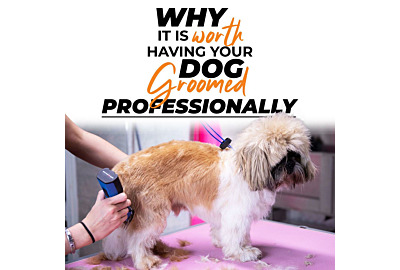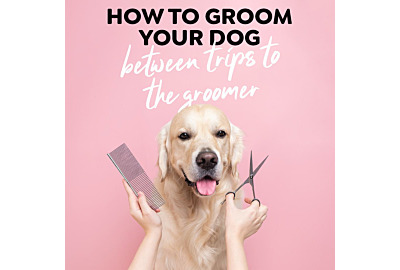
So, you’ve got a dog! Congratulations on your new family member! Now comes the tough part…how do you responsibly look after a dog? It can be significantly overwhelming when you walk into the pet shop for the first time and are greeted with all the different shampoos, brushes, and toys. That’s why we are here to guide and advise on how to responsibly care for your dog, from vaccinations to the right products for your pooch’s coat type.
First things first, let’s talk about all the essentials your dog will need:

Pet Health
Identity Tags:
By law (the control of dogs order 1992), it is a legal requirement that all dogs in a public place wear a dog’s collar and tag. This should contain your name and address, including your postcode, in case your dog gets lost.
Microchipping:
This must be done by the age of 8 weeks. This is permanent identification for your dog which enables them to be reunited with you in case they are lost. All dogs must be microchipped prior to applying for your dog license and it costs roughly between £10-£15 to microchip your dog.
Vaccinations:
Puppies can be vaccinated when they are between 6-8 weeks. Vaccinations are essential as they can prevent various fatal diseases such as Canine Parvovirus, Distemper, Infectious Canine Hepatitis, Leptospirosis and Rabies. Another vaccination to consider would be Kennel Cough, this would benefit you if you wanted to socialise your pet with other dogs which naturally happens when out walking or at the groomers. It is also a necessity if you use kennels to home your dog whilst you’re away.
Flea treatment:
This can begin from 6-8 weeks for your puppy. Ask your vet what treatment they would recommend for your dog, as depending on what treatment they recommend can determine how often they needs these treatments.
Worming:
Dogs need wormed every 3 months. The treatments can vary between tablets, liquids, pastes and spot on treatments. If you regularly visit the vet, they may offer a prescription for worming treatments, or you can also get non-prescription wormers in your local pet store.
Ticks
Ticks can be found by regularly brushing your dog, particularly after walks. There are many tick treatments, however ticks can be prevented. We recommend these products for removing ticks and prevention:
- Groom Professional Double Row Flea Comb
- Groom Professional Tick Remover
- Groom Professional Bye Bye Buzz Spray
Neutering:
This is the pro-active way to avoid unplanned pregnancies as animal centres are already oversubscribed. Unless you plan of safely breeding your dog, neutering is a great way to prevent any “accidents”, which could lead to further vet bills. Neutering costs approximately £110 - £350 depending on whether your dog is male or female and the veterinary practice.

Pet Wellness
Pet Insurance
This would be strongly advisable to have in place prior to taking your new puppy home with you. As you can never be certain when the pet insurance will benefit you. Pet insurance allows you to pay for veterinary bills more easily and offers protection from unexpected health issues with your pet. Research packages properly and ensure you have all the cover you will need included.
Nutrition
This is best advised by your vet, as they will know what nutrition your pet needs. However, pet foods that are branded as “complete” have all the appropriate nutrients needed for a healthy dog. These tend to be categorized by the life cycle of the dog, so if you have a puppy ensure you get the correct food in relation to their age.
Enrichment
Through this you are engaging your dog in activities designed to stimulate their mind and through this process they develop skills. These activities could include walking to heel, coming when called and meeting new people/animals. Dog’s often become more tired from enrichment than they do exercise, so if your pup has endless energy, enriching them more could make a world of difference.
Affection
Simply cuddling and showing love to your dog can relax them, make them feel safe, included, and understood.

Regular Grooming:
This can be created at home, in conjunction with regular salon visits. All types of coats need some TLC…some more than others. This is something that you should consider prior to choosing a dog breed, only you know how much time you have and how you will be able to adapt your routine for your dog.
In between trips to the groomer, we recommend grooming at home. By carrying out regular brushing you remove excess hair which allows more air to flow through the coat and this helps regulate your pet’s temperature. This is especially important if the dog has a curly coat.
Shampoos
As a dog’s skin has a different PH to humans, this requires them to have a different shampoo. Shampoos differ depending on what type of coat your dog has. Here are some of our recommendations per coat:
- Puppy Coat: Groom Professional Tender Puppy Kitty
- Combination Coat: Groom Professional Almond Detangle
- Wire Coat: Chris Christensen Spectrum One Coarse & Rough Coat
- Double Coat: Groom Professional 2 in 1 Protein
- Long Coat: Groom Professional Argan Oil
- Short Coat: Groom Professional Dirty Dogs Shampoo
- Smooth Coat: Groom Professional Raspberry Gloss
Brushing
Matted hair can lead to skin infections, but by brushing at home you reduce the risk of matting, whilst boosting the health and shine of the coat. Regular brushing allows your dog to get used to brushing, making your life easier for your dog and their groomer when they go to professional grooming appointments.
So, what brush do you need?
- Slicker Brush: removes excess hair and dirt from your pet’s coat. This leaves the coat soft and smooth. A flat slicker is ideal for soft coats, an amplifier can be used on any matted coat (or soft/wooly coats)
- Coat Rakes/Coat Kings: used to remove the loose, dead undercoat. Ideal for thick coated breeds. By removing dead hair, you can cut down on grooming time and prevent matting.
- Pin Brushes: ideal for medium to long coats, can also be useful for curly coats. This removes dead loose hair and tangles with the ball bins there to massage, which in turn stimulates hair growth
Nails
These should be checked and trimmed every 2 weeks. Nail care can be added onto grooms; however, you will still need to check the nails to ensure they’re healthy. Here are some products that you can use at home:
Ears
Ideally your dog’s ears should be cleaned at least once a month, as this prevents ear infections. For home cleaning the easiest products to use are:
Tear Staining
Some breeds are prone to tear staining. This can be easily kept on top of using some at home products that are proven to reduce the staining. You can use:
Oral Care
This is particularly important to prevent future issues with your dog. Through regular treatment you will reduce plaque, tartar and gum disease. Convenient products to use include:















